new posts in all blogs
Viewing: Blog Posts Tagged with: participatory, Most Recent at Top [Help]
Results 1 - 7 of 7
How to use this Page
You are viewing the most recent posts tagged with the words: participatory in the JacketFlap blog reader. What is a tag? Think of a tag as a keyword or category label. Tags can both help you find posts on JacketFlap.com as well as provide an easy way for you to "remember" and classify posts for later recall. Try adding a tag yourself by clicking "Add a tag" below a post's header. Scroll down through the list of Recent Posts in the left column and click on a post title that sounds interesting. You can view all posts from a specific blog by clicking the Blog name in the right column, or you can click a 'More Posts from this Blog' link in any individual post.

By: DanP,
on 8/3/2014
Blog:
OUPblog
(
Login to Add to MyJacketFlap)
JacketFlap tags:
Sociology,
Journals,
Media,
social change,
peacebuilding,
Social Work,
participatory,
Social Sciences,
*Featured,
valentina,
oxford journals,
Science & Medicine,
community development journal,
individual change,
participatory media,
participatory video,
relational change,
valentina bau,
relational,
Add a tag
By Valentina Baú
My research has focused on the use of participatory media in conflict-affected communities. The aim has been to demonstrate that involving community members in a media production provides them with a platform to tell their story about the violence they have experienced and the causes they believe led to it. This facilitates the achievement of a shared understanding of the conflict between groups that were fighting and lays the foundations for the establishment of a new social fabric that encompasses peace.
This is, by no means, an easy process. It is also one that requires the co-implementation of different types of interventions that strive to rebuild peace in those areas. However, what is often lacking in post-conflict contexts is a communication channel that allows people to reconnect. In the aftermath of civil violence, communities are left divided and in need of information to make sense of the brutality they have undergone. Victims and perpetrators live side by side as neighbours, and dynamics based on resentment and hatred hinder the return to a peaceful environment. The mass media are often unable to address the tensions that have remained within communities as a legacy of the conflict; hence, it is crucial to provide a platform where formerly opposing groups can articulate their views.
By drawing on the experience of a participatory video project conducted in the Rift Valley of Kenya after the 2007/2008 Post-Election Violence, when the country underwent a period of intense ethnic violence, I was able to demonstrate the potential of Communication for Social Change in post-conflict settings through the use of participatory video.
Social change is a process that seeks to transform the unequal power relations that affect a community. The literature on conflict studies tells us that, in order to achieve social change, what firstly needs to be targeted in conflict interventions is change both at the individual and relational level. Changing individuals requires adjusting their feelings and behaviours towards other groups, while changing relationships is about creating a meaningful interaction between members opposing groups, which results in the improvement of inter-group relations. This can be represented as follows:
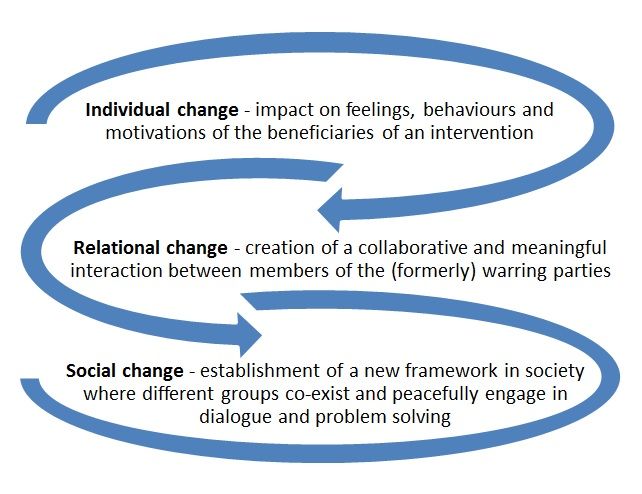
I argue that, from a communication perspective, these changes can be achieved when people participate in the production of a media story that allows them to both reflect upon and become aware of their situation, as well as to share their experience and create an understanding among groups.
In particular, collaborating towards the creation of media content, listening to one another and becoming producers of their own story, allows communities to transform conflict at all levels:
Individual change – participatory video activities contribute to instating participants’ confidence in re-establishing peace, helping them identify themselves as agents of change, and also guiding them in the discovery of new skills. The storytelling process people engage with encourages reflection on their actions during the violence and greater awareness of their present situation and the need to rebuild peace.
Relational change – the participatory video-making process can establish harmony among those who work together in the mixed-tribe workshops. These involve both those who are in front of the camera but also who cover other roles during the production process. Those who watch the final videos through public screenings can exchange views and develop an understanding of the situation for both victims and perpetrators.
Social change – Thanks to the power shifts resulting from newly-developed perceptions of the conflict and of their post-conflict environment, members of different groups begin to engage in dialogue. The existence of different realities of the violence and of the need to move forward are acknowledged, laying the foundations that are needed to begin to build a new social fabric.
A Communication for Social Change approach to peacebuilding recognises how changes at the individual and relational level can be addressed both through the media content production process and the screening of the final media outputs in the community. Within this context, participatory video is seen as a catalyst that can initiate processes of conflict transformation that lead to a wider social change.
Valentina Baú is completing a PhD at Macquarie University (Sydney, Australia). Both as a practitioner and as a researcher, her work has focused on the use of communication in international development. Valentina has collaborated with different international NGOs, the United Nations and the Italian Development Cooperation, in various African countries. Her doctoral research has looked at the use of Communication for Development in Peacebuilding, particularly through the use of participatory media. Valentina Baú is the author of ‘Building peace through social change communication: participatory video in conflict-affected communities‘, in the Community Development Journal.
Community Development Journal is the leading international journal in its field, covering a wide range of topics, reviewing significant developments and providing a forum for cutting-edge debates about theory and practice. It adopts a broad definition of community development to include policy, planning and action as they impact on the life of communities.
Subscribe to the OUPblog via
email or
RSS.
Subscribe to only social work articles on the OUPblog via
email or
RSS.
Image credit: Flow chart of social change, by Valentina Baú. Do not re-use without permission.
The post Transforming conflict into peace appeared first on OUPblog.


By: LaurenH,
on 5/13/2014
Blog:
OUPblog
(
Login to Add to MyJacketFlap)
JacketFlap tags:
Books,
Politics,
Current Affairs,
q&a,
recession,
finance,
investment,
budgeting,
banks,
participatory,
*Featured,
Business & Economics,
occupy,
After Occupy,
economic democracy,
mondragon,
tom malleson,
worker cooperative,
workers cooperatives,
malleson,
worker,
Add a tag
How do we address the problem of inequality in capitalist societies? Tom Malleson, the author of After Occupy: Economic Democracy for the 21st Century, argues that by making sure that democracy exists in both our economy and in our government, we may be able to achieve meaningful equality throughout society. We recently spoke to him about how economic democracy works and how viable it can be.
To start, give us a bare-bones description of what economic democracy is.
Economic democracy is the idea that democracy belongs not just in politics, but in the economy as well. There’s a paradox at the very center of our society: we call ourselves a democracy and yet a central part of society, the economy, has very little democracy in it at all. Workers do not elect the managers of their firms. Bankers do not allocate finance with any accountability to their communities. Investment decisions are not made with any citizen participation. That’s the philosophical paradox that After Occupy investigates. There are real, concrete examples of democratic alternatives in the economy out there, such as worker cooperatives in Spain and Italy, public banks in India, participatory budgeting in Brazil, capital controls in Malaysia, and so on. Ultimately, these alternative practices might be woven together to constitute a fundamentally different kind of society – a truly democratic one.
What exactly is a worker cooperative?
Worker co-ops are businesses that are owned and controlled entirely by the workers themselves. Workers elect the management on a one-person one-vote basis, just like we elect politicians into government. Probably the most famous co-op in the world is Mondragon in Spain. It started in 1956 with only five workers, and today employs over 80,000 people, with assets of over €35 billion. In addition to being far more democratic than conventional corporations, co-ops have two other important advantages. First, they have far less inequality of wages. In the United States, the average CEO makes 300 times the average employee of his or her company. For co-ops the ratio rarely exceeds 3:1. If co-ops spread, society as a whole would become significantly more equal too. In addition, co-ops also have far better job security. Instead of simply firing people in a recession, co-ops act in a much more humane way, usually by collectively agreeing to reduce their hours or take a pay cut across the board, instead of laying people off. That’s why in this last recession Mondragon has fired far fewer people than other Spanish firms. So if we had more co-ops here in the United States, the recession would have been far less devastating.

Are co-ops economically viable?
Absolutely. Economists have now been studying co-ops for over 30 years, and the conclusion is that worker co-ops operate with similar levels of efficiency to conventional firms. These results have been found again and again, in the United States, Uruguay, France, Italy, Spain, Denmark, the United Kingdom, and Sweden. Perhaps the most compelling evidence of viability is Northern Italy, where co-ops are more prevalent than in any other part of the world. In Emilia Romagna, for instance, they represent a substantial 12% of the region’s GDP, many co-ops have been around for decades, and the co-op sector dominates in a number of industries including construction, wine making, and food processing.
In After Occupy you argue that the current system of investment is undemocratic. What exactly do you mean?
The investment decisions that are made today — building highways or high-speed trains, condos or social housing, tar sands or green businesses — fundamentally determine the kind of society we will end up with tomorrow. Investment determines our future, which is why it must be accountable to us, the public. How could this happen? One important example is participatory budgeting, where local neighborhoods get to decide themselves on the kind of public infrastructure spending they want to see. In terms of finance, bank regulation is an obviously important first step. But over the long term, what is needed is a public banking system so that finances are allocated according to public need, not just according to private profit. Just like we have an electricity system and a post office that serves public needs, we need finance to do so as well (so that banks invest in poor communities or into green businesses – things that private banks will never do). At the end of the day, finance is simply too important for our future to be left to the banks.
Is having a true economic democracy feasible or is it simply a utopian?
Every proposal that is made in this book is based on real concrete examples. Worker co-ops already exist, as do public banks, participatory budgeting, etc. So we know there is absolutely nothing impossible about any of them – the institutions work. The difficult part, of course, is expanding them and bringing successful examples over from other countries. Some reforms (such as regulating the banks), are possible in the short-term; others, like building a large co-op movement, are the project of a generation. But the fact that we can see real-world examples of these things means that they are not at all utopian. With sufficient political will, a democratic economy is entirely within our reach.
Tom Malleson is the author of After Occupy: Economic Democracy for the 21st Century and is an Assistant Professor in the Social Justice and Peace Studies program at King’s University College at Western University, Canada. He is the co-editor of Whose Streets? The Toronto G20 and the Challenges of Summit Protest and the author of Stand Up Against Capitalism (forthcoming).
Subscribe to the OUPblog via email or RSS.
Subscribe to only politics articles on the OUPblog via email or RSS.
The post A conversation on economic democracy with Tom Malleson appeared first on OUPblog.

 Remember when the Summer Reading theme was "Be Creative?" If you have an artistic inclination, those were the days - with painting, sculpture, and other creative arts in the forefront! With the continued focus on the CCSS, and the upcoming science-driven theme of "Fizz, Boom, Read!", art runs the risk of being lost in the shuffle. Thankfully, there is an effort to combine them - turning STEM into STEAM - adding Art to the traditional Science, Technology, Engineering, and Math.
Remember when the Summer Reading theme was "Be Creative?" If you have an artistic inclination, those were the days - with painting, sculpture, and other creative arts in the forefront! With the continued focus on the CCSS, and the upcoming science-driven theme of "Fizz, Boom, Read!", art runs the risk of being lost in the shuffle. Thankfully, there is an effort to combine them - turning STEM into STEAM - adding Art to the traditional Science, Technology, Engineering, and Math.
Here, however, is a book that's all art - specifically, painting. Enjoy!
Kutschbach, Doris. 2014. Art Detective: Spot the Difference! New York: Prestel.
With the help of a cartoon dog named Charlie, readers explore famous paintings in an attempt to convict an art forger.
Hello! My name is Carl, but my friends call me Charlie the Sleuth. I'm a detective who solves art crimes, and right now I'm working on a very difficult case. It's about a shady artist and his forgeries - paintings he offers for sale that aren't really what they appear to be. ... Do you think you could help?
... and with that, the reader (now an art detective) begins a page-by-page quest to spot the differences between famous paintings and forgeries. Some are humorous. In "The Sunday Stroll" by Carl Spitzweg, the portly father in the forgery sports a Pinocchio nose and a baseball cap. Others are more subtle - the color of a parasol, insects in the tall grass. In all, nineteen paintings (and their accompanying "forgeries") are presented, including VanGogh, Gaugin, Rousseau, and Cézanne. Each has 15-25 differences.
What makes this book so wonderful is that it invites a deep exploration of each painting. Is greater realism produced by the blemish on a Cézanne melon? Does the addition of a bird in Passarro's "Place du Théâtre" detract from the hustle and bustle of Parisian citizens? These are not questions that kids will answer, but subconsciously, they may begin to see them. The reader cannot simply flip through the pages. If he does, the forger will not be found. By noting each mistake, he is compelled also to notice the aesthetic produced by the artist's choices.
The final pages offer thumbnails of each painting with the differences marked by X's. A note is included about each painting, it's painter, and noting its current location.
Enjoy the search!
Note: This book is marked with the seal of the Forest Stewardship Council (FSC), indicating that its paper was derived from "responsible sources." This is the first time I've seen this logo. I hope to see it more often!
This book is marked with the seal of the Forest Stewardship Council (FSC), indicating that its paper was derived from "responsible sources." This is the first time I've seen this logo. I hope to see it more often!
Don't miss today's
Nonfiction Monday postings, and be sure to catch up on all of the great posts on


By: Alice,
on 9/5/2012
Blog:
OUPblog
(
Login to Add to MyJacketFlap)
JacketFlap tags:
*Featured,
Law & Politics,
eastwooding,
David Karpf,
homophily,
hybrid news environment,
Invisible Obama,
MoveOn Effect,
participatory bias,
political media,
politically-engaged,
Republican National Convention 2012,
Unexpected Transformation of American Political Advocacy,
invisibleobama,
eastwood’ers,
eastwood’s,
Current Affairs,
Media,
social media,
Barack Obama,
Letterman,
twitter,
Clint Eastwood,
saturday night live,
Internet meme,
infotainment,
participatory,
Add a tag
By David Karpf
Clint Eastwood took the stage at the Republican convention last week and gave a… well, let’s call it a memorable performance. I’m not sure if there’s ever been such a bizarre prime time address given at a national convention. The celebrated actor/director spent eleven minutes in a mumbling debate with an empty chair representing President Obama. Political conventions are highly-scripted events. Eastwood’s extended, failed ad lib was anything but scripted.
In years past, such a performance would have provided fodder for late-night comedians, but little more. Saturday Night Live and Letterman could weigh in, while you and I were left to passively chuckle. Living in the age of social media, events unfolded at a different pace and among different participants.
Within minutes, an anonymous Twitter user registered the name @InvisibleObama. Conjuring shades of @MayorEmanuel, the participatory features of the hybrid news environment allowed formerly-passive members of the audience to swap jokes. That evening, Twitter users launched a new hashtag, “#eastwooding,” wherein individuals post pictures of themselves pointing at empty chairs. Thusly a new “meme” was born.
Within less than a day, @InvisibleObama has attracted over 55,000 Twitter followers. Newsweek/DailyBeast has posted an #Eastwooding “best of” list. CNN covered it as well. Participatory engagement with Eastwood’s odd performance made itself became the subject of news.
The President himself even weighed in, tweeting “This Seat’s Taken.”
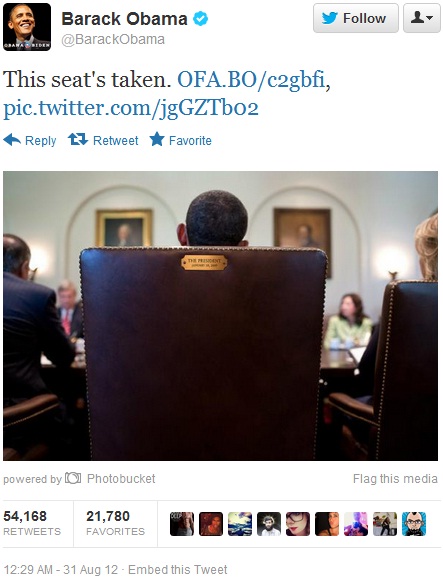
This is all in good fun, of course. Twitter during national events adopts the texture of a giant Mystery Science Theater 3000 episode. But in the course of this distraction, one might wonder, does it actually make any difference?
I would argue that political memes and twitter games like #eastwooding have a very specific, but very limited, effect.
Let’s start with the obvious limitations: @InvisibleObama and #Eastwooding will have no direct impact on the outcome of the 2012 election. These are games played by the already-politically-engaged. 55,000 Twitter followers is a drop the ocean compared to the ~38 million total viewers of the Republican National Convention, or the 100 million+ citizens who will cast a vote in the November election. Individuals who #Eastwood are among the most attentive segments of the populace. They’re also more likely to be liberal. Conservatives have taken to defending Eastwood’s display as counter-intuitively good for Romney. #Eastwood’ers have already made up their minds, and they each only have one vote.
Secondary effects are also pretty limited. Politically-aware Twitter users tend to be connected to one another (social network theorists call this phenomenon “homophily”). We should not expect individuals who chose to ignore the RNC convention to pick up on it after-the-fact due to social media chatter.
Furthermore, memes of this sort have a pretty brief half-life. With the Democratic National Convention scheduled for this week, the hybrid media system will quickly turn its attention to a new set of images and statements. One impact of new media on political news is that the “churn” of the news cycle has sped up. Congressman Todd Akin’s outlandish claims about female biology already seem part of the distant past. By the time of the October Presidential debates, #Eastwooding will have been replaced a half-dozen times. We shouldn’t expect it to be on anyone’s mind when they enter the voting booth.
That said, the limited size and duration of these Twitter memes doesn’t render them useless. In very particular ways, this participatory nature of the new media system has an important effect on media and politics today.
Consider this post as an example:
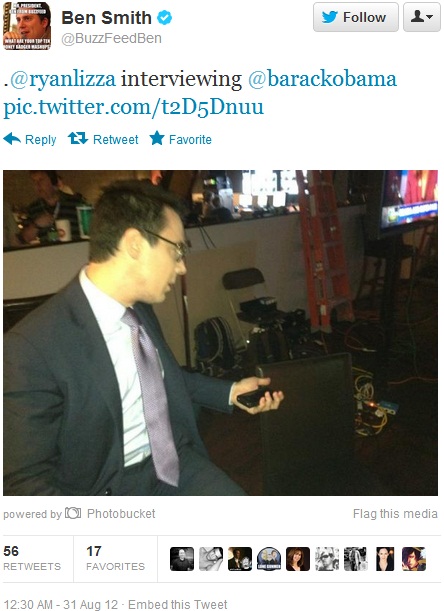
BuzzFeedBen is Ben Smith, formerly of Politico.com, current editor-in-chief of Buzzfeed.com. Ryan Lizza is an accomplished political journalist whose work has appeared in The New Yorker, The New Republic, The Atlantic, and Vanity Fair. Other journalists, such as Slate’s Dave Weigel, also joined in the fun.
These journalists aren’t revealing some hidden liberal bias through their actions; they are revealing a participatory bias. A small segment of the US population pays a lot of attention to politics. The hybrid media environment allows journalists to engage with these attentive citizens. The interactions can help shape news coverage, or (in cases where the media runs stories on #Eastwooding) become the subject of news coverage. Rather than writing about the policy details (or lack thereof) in Romney’s acceptance speech, many news outlets turned instead to Eastwood’s odd performance, and the global audience’s playful reaction. This changes the texture and content of media coverage.
The Internet didn’t cause this merger of news and entertainment. It began in the 1980s, as newsrooms sought higher ratings and larger profits. Political communication scholars raised concerns about “infotainment” before the average citizen owned a modem. Twitter isn’t the cause of this merger; it is merely the latest iteration.
The limitations of these incidents are likewise nothing new. Everyday political gaffes don’t determine the outcome of a national election. Today’s media environment churns faster, so we see more of the gaffes. It is also more segmented, so those of us who aren’t interested in seeing them can tune out more easily.
Cases like #Eastwooding provide a variation on these longstanding trends. American politics has accepted the blurring of political news and political entertainment. Social media provides a participatory element, making the entertainment aspects much more entertaining.
David Karpf is an Assistant Professor in the School of Media and Public Affairs at George Washington University. He is the author of The MoveOn Effect: The Unexpected Transformation of American Political Advocacy. His research focuses on the Internet’s disruptive effect on organized political advocacy. He blogs at shoutingloudly.com and tweets at @davekarpf.
Oxford University Press USA is putting together a series of articles on a political topic each week for four weeks as the United States discusses the upcoming American presidential election, and Republican and Democratic National Conventions. Our scholars previously tackled the issues of money and politics, and the role of political conventions. This week we turn to the role of media in politics. Read the previous article in this series: “Networked politics in 2008 and 2012.” And you can see OUP’s contribution to #Eastwooding on Google Plus.
Subscribe to the OUPblog via email or RSS.
Subscribe to only law and politics articles on the OUPblog via email or RSS.
Subscribe to only media articles on the OUPblog via email or RSS.
View more about this book on the 

Image credits: Both screencaps were taken on 4 September 2012 at 11:11 am ET.


By: shelf-employed,
on 8/13/2012
Blog:
Shelf-employed
(
Login to Add to MyJacketFlap)
JacketFlap tags:
J,
eyes,
Non-Fiction Monday,
E,
lift-the-flap,
participatory,
book review,
nonfiction,
animals,
Add a tag
Frattini, Stéphane. 2012. Who's Looking at You? New York: Sterling.

Eighteen 8"x8" pages feature eighteen different eyes peering out at the reader. Each eye is on a flap nearly as big as the page with a narrow, brightly colored frame surrounding it. Open the flap to see "who's looking at you," and learn a few facts, focused, not surprisingly, on the eye.
Snail
How did this hungry snail find the leaf? Snails can't see very well - they mostly depend on touch and smell to find their way. But most snails do have eyes, right at the ends of two bendable tentacles called eyestalks.
The snail is actually one of the easier eyeballs to recognize. Very young children won't find many easy guesses as it's surprisingly difficult to determine some animals from a single eye, but slightly older kids will have fun with
Who's Looking at You? Even the adults at the library were enjoying this one! Some of the featured eyeballs are those of the gorilla, wolf, cuttlefish, chameleon, and blue-spotted grouper. The butterfly is a bit of stretch - the photo features the "fake" eye that some butterflies sport on their wings to fool predators. The inside back cover contains eight additional eyes for guessing, with small flaps hiding nothing more than the animal's name.
The photography is beautiful and the guessing is fun!

By: shelf-employed,
on 5/19/2011
Blog:
Shelf-employed
(
Login to Add to MyJacketFlap)
JacketFlap tags:
rhyming,
imagination,
book review,
nonfiction,
animals,
colors,
chickens,
pigs,
mothers,
bedtime stories,
storytime,
E,
participatory,
Add a tag
I am in the midst of transferring from one branch to another, and I now have two desks overflowing with great new books! Here are a few:
Gibbs, Edward. 2011. I Spy with my Little Eye. Somerville, MA: Templar. (Candlewick) That big (almost 2.5"), yellow, circular eye on the cover is actually a hole - an oh, the things we can spy through that hole! On a predominantly white spread with an eye on the left page and a circle of blue on the right, we read,
I spy with my little eye ... something that is blue. "I am the biggest animal in the world."
Turn the page to find a richly colored blue whale, which due to some artfully placed curlicues, manages to appear realistic and at the same time, fanciful.
I'm a BLUE WHALE.
Each featured animal unfolds in the same manner. The rear cover of the book features a hole for your own little eye to go spying! Colors, animals, guessing - this book has it all!
Edward Gibbs is listed as a "debut artist." What a debut! This one's dynamite!
Tusa, Tricia. 2011. Follow Me. Boston: Harcourt.
From the book jacket, here is the description of the art,
The illustrations in this book were done using an etching process with monoprinted color. The text type was set in Prin. The display type was set in Rats and Carrotflower.
(Rats and Carrotflower? - love that one!) What this means to me is a softly-colored book with fanciful drawings outlined in etched brown lines. The color sometimes spills out of its intended (?) perimeter in much the same way that the young protagonist spills out of her swing and floats and flies through the breezes, "lost in small, green, happy music." She invites the reader to follow her through all of nature's colors, "deep into brown, into the bright white of yellow, into orange that slips into red." From the illustrator of
In a Blue Room, another beautiful book!
 Johnson, Lindsay Lee. 2011. Ten Moonstruck Piglets. Ill. by Carll Cneut. Boston: Clarion.
Johnson, Lindsay Lee. 2011. Ten Moonstruck Piglets. Ill. by Carll Cneut. Boston: Clarion.All in a scramble,
all ready to gambol,
ten moonstruck piglets
on a midnight ramble.
Through the mud wallow,
beyond the wide hollow,
leapfrogging piglets
in turns lead and follow.
It's all fun and games until the moon goes behind a cloud! But not to worry - Mama's coming. These sleepy-eyed, wrinkly little runts are irresistible!
Where
Ten Little Piglets is filled with amusing detail, this next book features uncomplicated simplicity ... (but in both books, you can count on mom to the rescue!)
Read more »

By: Lauren,
on 2/15/2011
Blog:
OUPblog
(
Login to Add to MyJacketFlap)
JacketFlap tags:
Economics,
Sociology,
mexico,
human rights,
Propaganda,
Latin America,
poverty,
millennium development goals,
participatory,
*Featured,
susan pick,
breaking the poverty cycle,
live better,
vivir mejor,
mejor”,
“vivir,
Add a tag
By Susan Pick
With all the ambitious international goals and targets that developing countries have committed to, from poverty reduction to universal education and access to health care, we’ve observed a not uncommon response by the governments: too strong a focus on the public image of the new programs, not strong enough a focus on making the programs truly accessible. Here’s an example to illustrate our point: On a daily basis, Mexicans are exposed to immeasurable social development propaganda from government agencies. The propaganda is unavoidable because these messages are disseminated via commercials on public transportation, highway billboards, TV and radio, and posters in the most rural communities. Some of the current hot topics of these campaigns are diabetes and childhood obesity, nonviolence toward women and anti-corruption laws.
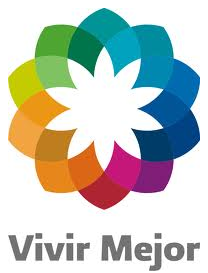 “Vivir Mejor” (“Live Better”) is the federal government’s umbrella strategy behind many of these flashy ads, and its aim is to eliminate extreme poverty and promote sustainable human development throughout the country. The rainbow-colored logo is impossible to miss and is stamped on nearly everything the government is involved with. “Vivir Mejor” social development campaigns share with the public the services they are entitled to. A man that never got the chance to study when he was young is now completing his secondary education – and you can do the same, for free! A smiling woman is receiving free prenatal health care –and you can sign up for it as well, it’s simple! In addition, many of the “Vivir Mejor” campaigns encourage the public to exercise their rights. This involves procedures like signing up for government health insurance, filing a report in the case of sexual harassment, and requesting information from the government’s transparency portals.
“Vivir Mejor” (“Live Better”) is the federal government’s umbrella strategy behind many of these flashy ads, and its aim is to eliminate extreme poverty and promote sustainable human development throughout the country. The rainbow-colored logo is impossible to miss and is stamped on nearly everything the government is involved with. “Vivir Mejor” social development campaigns share with the public the services they are entitled to. A man that never got the chance to study when he was young is now completing his secondary education – and you can do the same, for free! A smiling woman is receiving free prenatal health care –and you can sign up for it as well, it’s simple! In addition, many of the “Vivir Mejor” campaigns encourage the public to exercise their rights. This involves procedures like signing up for government health insurance, filing a report in the case of sexual harassment, and requesting information from the government’s transparency portals.
Making people aware of their rights and the social programs they can benefit from is indispensable…in theory. How can these types of public campaigns possibly be inefficient? Why aren’t poor people in Mexico seeking health care or going back to school or reporting abuse of their basic human rights? The first problem is most obvious: there are incredible structural barriers to accessing social services in Mexico; widespread corruption and absurdly bureaucratic procedures prevent Mexicans from registering for social programs or filing reports when their rights are violated.
The second problem is less obvious, but its solution is essential for Mexico to achieve its development objectives: there is a severe lack of civic engagement in Mexico. The lack of participation in pubic affairs that this implies results in the absence of social action and citizen monitoring, as well as the underutilization of government programs. The unengaged citizen lacks psychological preparedness for accessing his or her rights and seeking opportunities for personal development. Some examples of psychosocial barriers to participatory citizenship include the internalization of feelings of inferiority, a lack of intrinsic incentive to bring about change, and insufficient communication and team work skills. All of these factors are directly related to what’s been labeled “low intensity citizenship” in Mexico (Ochoa Espejo).
The solution to the problems we mention lies in the development of an individual’s personal agency. In other words, she needs to feel empowered and entitled to make changes in her life. If social programs were designed to facilitate the acquisition of psychosocial tools like assertive communication, autonomous decision-making, and critical thinking in addition to classic welfare services, citizens would become participatory agents of change. Once engaged, the everyday citizen has an incredible pow







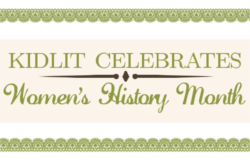







The book cover looks scary - definitely one that most boys would pull out from the shelves. I'm glad to hear that even the adults were having fun with the book. Will check it out.
what a great idea for a book... here's lookin' at you, kid.